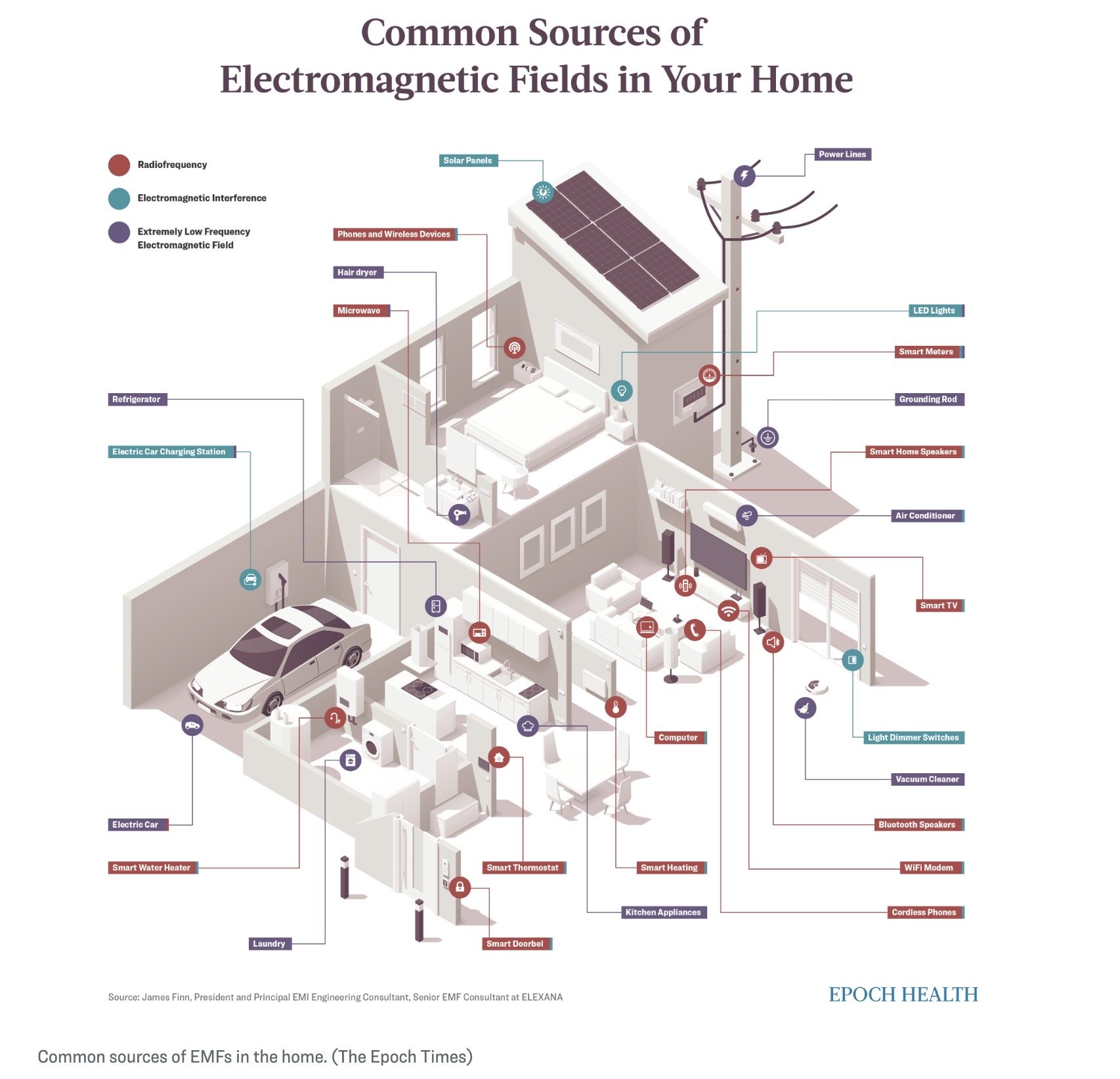Common Sources of Electromagnetic Radiation in a Home or Office
You can see in the fine print credits that James Finn of Elexana was the resource person for this diagram made by the Epoch Times.
Here is the Epoch Times article featuring James Finn of Elexana.
Common Sources of Electromagnetic Fields in Your Home
Low-Frequency (ELF) – 50/60 Hz Power Systems
Frequency Range: 0–300 Hz
AC electrical wiring (in walls, floors, and ceilings).
Power strips and extension cords.
Electrical panels and circuit breaker boxes.
Power transformers and subpanels.
Fluorescent light ballasts and LED drivers.
Electric space heaters and floor heating systems.
Radiation Type: Magnetic fields (ELF), especially from current-carrying conductors
Intermediate Frequencies – kHz Range
Frequency Range: 300 Hz – 300 kHz
Compact fluorescent lamps (CFLs).
Dimmer switches (phase-cutting circuits).
Older LED lighting has poor EMI suppression.
Switching power supplies in chargers and electronics.
Induction cooktops.
Wired alarm systems and outdated intercoms.
Radiation Type: Conducted and radiated emissions, often with harmonic distortion.
High-Frequency – Radio Frequency (RF) Sources
Frequency Range: 300 kHz – 300 GHz
Intentional RF Emitters:
Wi-Fi routers (2.4 GHz, 5 GHz, and 6 GHz bands).
Mobile phones (700 MHz to 2.6 GHz, including 5G sub-6 GHz).
Cordless phones (typically 1.9 GHz – DECT standard).
Bluetooth devices (1.7 to 2.4 GHz).
Smart speakers and IoT devices.
Wireless security cameras and baby monitors
Wireless keyboards, mice, and peripherals.
Smart thermostats, smart plugs, and Zigbee hubs.
Unintentional RF Emitters:
Computer motherboards and GPUs (switching edges and harmonics).
Monitors and displays (especially with fast refresh rates).
Power-over-Ethernet (PoE) devices.
Ethernet cables (poorly shielded or improperly grounded).
USB and HDMI cables (when acting as antennas).
Cheap or counterfeit switching AC-DC adapters.
Radiation Type: Electric fields, radiated RF, and common-mode noise emissions.
Static Magnetic or Electric Fields
Permanent magnets (e.g., in speakers or motors).
Static electric fields from synthetic carpet and furniture.
Electrostatic discharge (ESD) buildup on screens or metal surfaces.
Radiation Type: Static fields (DC) can influence sensitive persons and electronic circuits nearby.
Medical and Specialized Sources (if applicable)
TENS units, EMF therapeutic devices.
Ultrasonic pest repellents.
UV-C disinfection lamps (can radiate stray fields).
MRI rooms (if in commercial buildings near imaging centers).
Situational Amplifiers of EM Radiation
Poor grounding or unbonded metal surfaces.
Multiple Wi-Fi access points operating in close proximity.
AC-powered equipment near sleeping areas.
Wireless devices with auto-connect or frequent beaconing enabled.
Equipment in standby mode emitting periodic RF pulses.
Typical Measurement Tools for Home/Office EMF Surveys
Gaussmeter (AC magnetic fields).
Magnetometer (DC magnetic fields).
Electrostatic Meter (for people with Implanted Medical Devices).
Broadband RF meter (for RF from 1.0 MHz to 40 GHz).
E-Field Meter (for 50-60 Hertz to 10 MHz).
Voltmeter (for 50-60 Hz to 400+ kHz).
Power line EMI analyzer or an Oscilloscope (for conducted noise from wiring).
Near-field probe, antennas, and a spectrum analyzer (for advanced diagnostics).
Ground Tester
Geiger Counter (for special situations).


